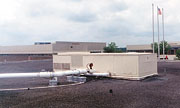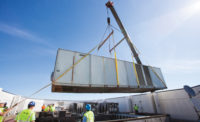One manufacturer, Calmac Corp., has created the Roofberg® system, which permits conventional rooftop units to be converted to a central chiller system with ice storage.

HOW IT WORKS
“Roofberg is an application of off-peak cooling, sometimes called thermal energy storage. The application can be applied to existing rooftop facilities whose rooftop cooling equipment is unreliable, inefficient, or perhaps undersized,” explains Paul Valenta, North American sales manager, Calmac Manufacturing Corp., Gibsonia, PA.Roofberg consists of a chiller, ice storage tanks, and one or more rooftop units whose evaporator coils were converted from refrigerant to use a glycol solution for cooling. The ice storage tanks contain a heat exchanger made of coiled polyethylene tubing through which a solution of ethylene glycol passes. Water is stored inside the tank and surrounds the tubing so that ice is formed around the tubing. The ice storage process continues until most of the water in the tank has frozen.
Once the ice is made, it is stored each night in order to meet the building’s daytime cooling demand. During the discharge process, ethylene glycol is circulated through the coils, where it is cooled by the melting ice, and to the rooftop units to provide cooling to the building. The ice storage component minimizes or eliminates the cooling demand of the building from the operation of the chiller.
The chiller can operate at night (cooler, more efficient condensing temperatures) to meet a portion of (partial storage) or all (full storage) of the daytime cooling demand. The flexibility of partial storage permits a smaller chiller to satisfy a larger peak cooling load. Furthermore, the system can shift the cooling demand to off-peak hours when electricity from the utility is generated more efficiently, with lower greenhouse gas emissions and at lower cost.
“The Roofberg system is best applied to larger, packaged unit facilities — for example, applications with air conditioning systems that consist of multiple 20-ton-plus rooftop units, where units are going to be replaced for one reason or another,” says Valenta.
“Economically, comparing a Roofberg application investment to status quo will not be favorable in most instances. There must be a need to make a change,” he states.
CAN BE USED ALMOST ANYWHERE
Retrofitting the Roofberg into an existing system isn’t particularly difficult either. “Old direct-expansion [DX] coils are field equipped with chilled-water headers. Existing blowers, plenum, curb, and ductwork are reused for maximum economy. The rooftop’s compressor and condenser are simply disconnected and left in place,” says Valenta.In addition to eliminating the condenser coil and compressor, a Roofberg retrofit involves updating the casing and fan section, if required, with new paint, insulation, motors, or drives, and converting or replacing the existing refrigerant coil to a chilled-water coil that would use a formulated heat transfer fluid to remove heat. “Essentially, the application converts the packaged DX unit to a chilled-water rooftop air handler that is then connected to an off-peak cooling system using chillers and ice storage tanks,” says Valenta.
Energy savings and minimizing demand charges are the primary reasons to consider a Roofberg system. According to the company, a large East Coast electric utility documented a 43% reduction in demand charges and a 12% drop in total energy usage when three 15-year-old rooftops at a New Jersey middle school were retrofitted to a Roofberg system.
The benefits of the system, according to Valenta, can be broken down into lower operating costs, improved comfort, and lower first cost:
Lower operating costs:
Improved comfort:
Lower first cost:
The Department of Energy’s (DOE’s) Federal Energy Management Program (FEMP) set up seven case studies involving the Roofberg. The results of these different scenarios can be found on its website (www.eren.doe.gov/femp/prodtech/icesum.html).
How the Roofberg performed compared to conventional rooftop units depended on the system design, electricity rates, and demand charges.
For more information, contact Calmac Manufacturing at www.calmac.com (website).
Publication date: 06/24/2002


